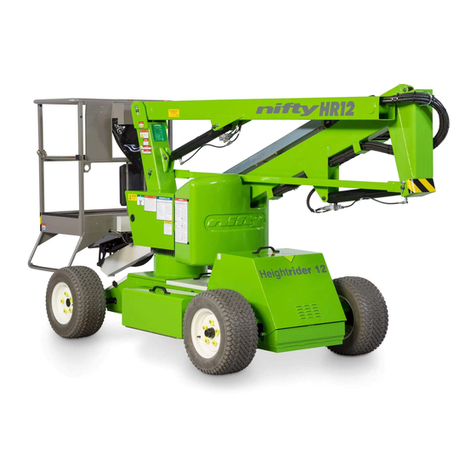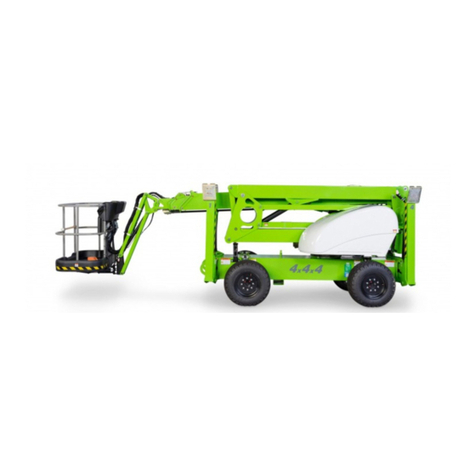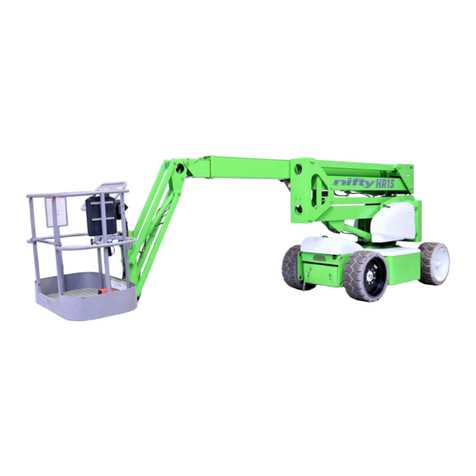
SD Series
Operating & Safety Instructions
USA 10/12
2 Safety
2.1 MANDATORY PRECAUTIONS
When operating your Niftylift, your safety is of utmost concern. In order to fully appreciate all aspects
of the machines operation it should be ensured that each operator has READ and fully UNDERSTOOD
the relevant manual covering machine use, maintenance and servicing. If any doubts exist concerning
any points covered in your manual, contact your local dealer or Niftylift Ltd.
Before using any Niftylift, thoroughly inspect the machine for damage or deformation to all major
components. Likewise, check the control systems for hydraulic leaks, damaged hoses, cable faults or
loose covers to electrical components. At no time should damaged or faulty equipment be used -
Correct all defects before putting the basket to work. If in doubt, contact your local dealer or Niftylift Ltd
(see front cover for address).
THE MANUFACTURER HAS NO DIRECT CONTROL OVER THE MACHINE
APPLICATION AND USE. THEREFORE CONFORMATION WITH GOOD SAFETY
PRACTICES IS THE RESPONSIBILITY OF THE USER AND HIS OPERATING
PERSONNEL. FAILURE TO UNDERSTAND AND FOLLOW ALL SAFETY RULES
COULD RESULT IN SERIOUS INJURY OR DEATH.
2.1.1 Only persons trained on the same or a similar model will be permitted to operate the aerial Niftylift.
2.1.2 Always operate the Niftylift in full accordance with the manufacturers Operating & Safety Instructions
for that model.
2.1.3 Before use each day and at the beginning of each shift the Niftylift shall be given a visual inspection
and functional test including, but not limited to, operating and emergency controls, safety devices,
personal protective clothing, including fall protection, air, hydraulic and fuel system leaks, cables and
wiring harness, loose or missing parts, tyres and wheels, placards, warnings, control markings and
Operating and Safety Manuals, guards and guard rail systems and all other items specified by the
manufacturer.
2.1.4 Any problems or malfunctions that affect operational safety must be repaired prior to use of the Niftylift,
with specific regard to any safety components refer to the Parts Manual for part numbers and details. If
in doubt, contact Niftylift Ltd (Details on page 3). Ensure wheels are chocked before carrying out
any maintenance that involves brake release as described in Section 4.8.2 – Towing.
2.1.5 Always ensure that all warning labels, instructions, placards, control markings and Safety Manuals are
intact and clearly legible. If replacements are required contact your local dealer or Niftylift. Always
observe and obey safety and operating instructions on such labels.
2.1.6 Do not alter, modify or disable in any way the controls, safety devices, interlocks or any other part of
the machine.
2.1.7 Before the Niftylift is used and during use the user shall check the area in which it is to be used for
possible hazards such as, but not limited to, uneven ground drop-offs, holes, bumps, obstructions,
debris, floor and overhead obstructions, high voltage conductors, wind and weather, unauthorised
persons and any other possibly hazardous conditions.
2.1.8 Never exceed the maximum basket capacity, as indicated on the decals and machine serial plate.































